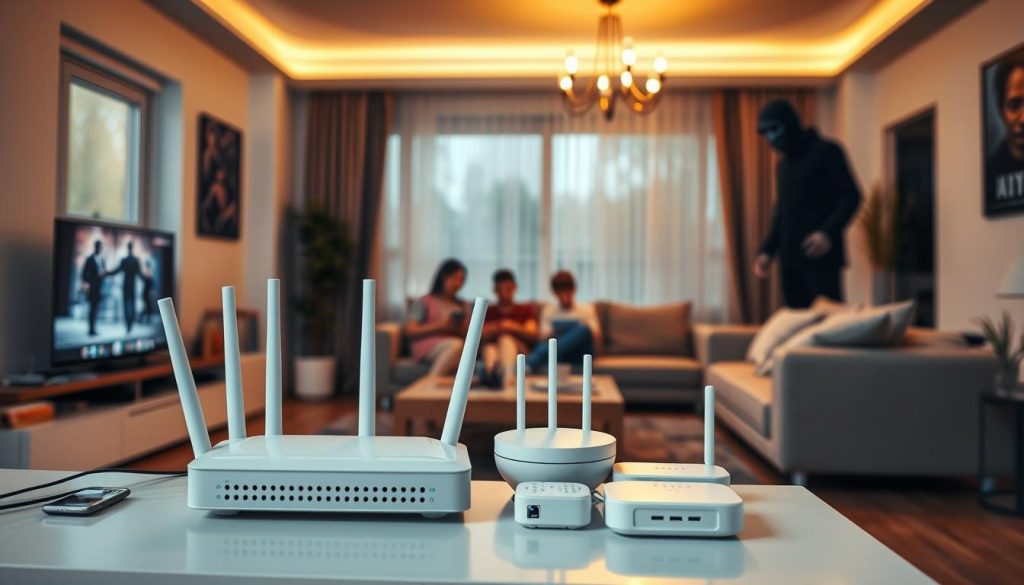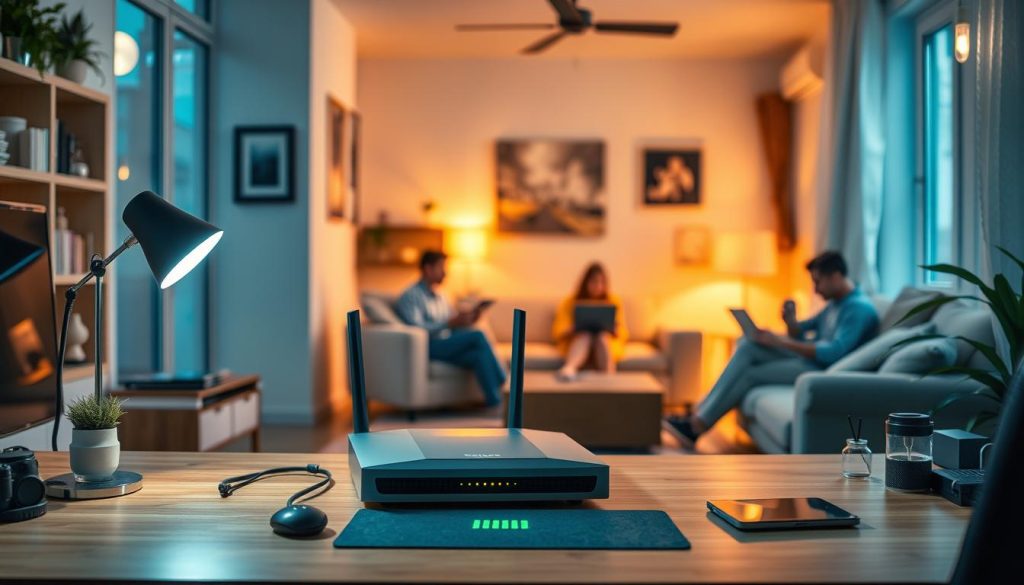Protecting your living space now starts with clear, practical steps. In this guide you’ll learn how to keep convenience without giving up privacy or safety. HomePrivacyNetwork.com helps you take action with easy tutorials and videos on our YouTube channel and blog.
Real risks exist: voice assistants have been fooled by lasers, robot vacuums have been hijacked, cameras have exposed neighbors, and whole systems fell through a single smart plug compromise. The FBI recommends isolating IoT traffic from laptops and phones.
Over the next pages you’ll get a step‑by‑step plan for securing smart home technology, hardening your Wi‑Fi network, and applying account‑level safeguards like unique passwords and multifactor authentication.
You’ll leave with a concise checklist and trusted guidance so you can monitor who’s on your network, choose safer products, and keep your family’s digital life protected across the internet.
Why securing smart home devices matters right now
A single unchecked gadget can give intruders a path into your network. Smart TVs, cameras, and outdoor gear often ship with default credentials or weak protections. That makes the risk real and immediate for every household.
You face evolving threats from hackers who exploit defaults and lax setup. Popular camera systems have been breached, with attackers taunting residents or demanding ransom. Televisions have been hijacked to show inappropriate content.
Many products collect and transmit personal data across the internet and associated services. If you don’t verify update policies or change defaults, you increase exposure for yourself and family members.
Act now by treating your living room TV, router, and thermostat like small computers. Regular maintenance, cautious pairing, and review of privacy settings cut risk. For ongoing, trusted guidance, visit HomePrivacyNetwork.com, subscribe to our YouTube channel, and check the blog for timely alerts and how‑tos.
Understand the risks across your home before you connect
Do a room-by-room sweep to spot weak links before you pair anything to the network. A quick audit helps you find gear that can be probed from the street or exploited once online.
Outdoor entry points
Check cameras, doorbells, garage controls, and sprinklers first. Garage door openers and wireless doorbells can be scanned from outside using simple Wi‑Fi transmitters.
Change default passwords and disable remote access you don’t need to reduce drive‑by probing and abuse.
Living room threats
Inspect your TV, speakers, voice assistants, and router. Unpatched TVs and microphones can be used to spy on users or pivot to other products on your network.
Keep firmware current and limit which systems can communicate with the router.
Private spaces and kitchens
Review biometric beds and internet‑connected appliances for what data they collect and where it is stored. Some kitchen appliances have had vulnerabilities that allowed network access.
Document model numbers and app accounts, decide what truly needs internet access, and plan segmentation for iot devices that shouldn’t talk to your laptops or phones.
- Map connections between assistants, TVs, cameras, and cloud services.
- Scan for forgotten plugs, bulbs, and hubs that are still online.
- For deeper room‑by‑room checklists and video walkthroughs, visit HomePrivacyNetwork.com and subscribe to our YouTube channel.
Harden your home network first
Begin with the network: a hardened router stops many attacks before they reach other gear.

Lock down Wi‑Fi by renaming the SSID to a non‑identifying label and setting a long, unique password. Enable WPA2 or WPA3 in the router settings and confirm the firewall is active. Create a strong admin password that differs from the Wi‑Fi passphrase and save it in a password manager.
- Run firmware updates from the manufacturer’s app or portal and enable auto‑updates when available.
- Disable unused features like WPS and UPnP, and limit remote management to trusted methods.
- Replace aging routers with Wi‑Fi 6 or Wi‑Fi 7 models or adopt a mesh system for better coverage and centralized controls.
Document and test your plan: back up the router configuration, note primary and guest SSIDs, and check the client list regularly to remove unknown entries. Stage changes during low‑use times to avoid disruption.
Get step‑by‑step Wi‑Fi hardening videos on HomePrivacyNetwork.com’s YouTube channel and download our router setup checklists from the blog for guided protection.
Securing smart home devices step by step
Treat every product like a mini computer: set strong access controls from day one. Start with account hygiene, then add layered protections so a single breach does not cascade.

Create strong, unique passwords and use a password manager
Make sure you generate strong passwords and unique passphrases for every device account. Use a reputable password manager to store and autofill credentials so you never reuse logins.
Enable multi‑factor authentication on every supported account
Turn on MFA via authenticator apps (Google Authenticator, Authy) for services tied to your device ecosystem. MFA stops stolen passwords from giving attackers full account access.
Keep firmware and apps updated; register devices with the manufacturer
Register each product to receive firmware alerts and install updates for both device software and companion apps. Set monthly reminders to check for manual patches.
Review and tighten privacy settings; disable unnecessary features and remote access
Audit privacy dashboards, revoke unused permissions, and turn off features you don’t use. Disable UPnP and default remote access to reduce exposure.
- Separate admin and user accounts when possible.
- Keep a secure inventory of serial numbers and recovery steps.
- Test backup codes and recovery paths before you need them.
| Action | Recommended Tool | Frequency | Notes |
|---|---|---|---|
| Create unique passwords | 1Password, Bitwarden | Once per account | Use long passphrases and store in manager |
| Enable MFA | Authy, Google Authenticator | On setup | Prefer app-based codes over SMS |
| Register & update | Manufacturer portal | Monthly | Subscribe to firmware alerts |
Segment and safeguard: isolate IoT and use protected connections
Isolating less-trusted equipment keeps breaches from hopping onto your main systems. Start by creating a separate guest SSID or VLAN for low‑trust gear so a compromised product can’t easily move laterally to laptops and phones.

Put IoT on a guest network or separate VLAN
Many modern routers support guest SSIDs that isolate traffic by default. Place iot devices on a 2.4 GHz band or a dedicated VLAN and keep your personal computers and phones on the main SSID.
Standardize naming (for example, “Home‑IoT”) and document the password to simplify onboarding while preserving control.
Access equipment safely on the go with a virtual private network
Use a virtual private network on your phone or laptop before you connect from public hotspots. Avoid logging into cameras or controllers over open -fi network connections without a VPN.
- Restrict inter‑LAN routing for guest segments to stop lateral access.
- Disable port forwarding when possible and prefer secure relay or VPN tunnels.
- Test segmentation by trying to ping between segments; no response confirms isolation.
| Action | Why it helps | How often |
|---|---|---|
| Guest SSID/VLAN | Limits spread if one gadget is attacked | Once, review yearly |
| VPN for remote access | Encrypts traffic over public networks | Every remote session |
| Firewall & router updates | Maintain protection and fix bugs | Monthly |
Watch our guest network and VLAN walkthroughs on the HomePrivacyNetwork.com YouTube channel, and download printable segmentation diagrams from the blog to guide setup.
Monitor, maintain, and choose products wisely
Knowing who and what is on your network is the best place to start defending it. Visibility gives you clear steps to act when something looks wrong.

See who’s on your network and consider comprehensive security suites
Run a client scan with tools like Wireless Network Watcher to list connected users and gadgets. That quick check helps you spot unknown entries and forgotten plugs.
Consider dedicated hardware such as Firewalla to visualize traffic, enforce rules, and get real‑time alerts. Comprehensive security suites also add a layer of protection and offer home network maps.
Adopt an update cadence and favor reputable brands with clear policies
Establish an updates routine—check firmware and app patches monthly and log changes. Regular updates are one of the simplest ways to reduce risk.
Prefer products from manufacturers that publish update schedules, changelogs, and transparent privacy commitments. Review each maker’s privacy policy to understand how your data is handled.
- Retire unsupported models and factory‑reset before disposal or resale.
- Centralize serials, support URLs, and warranty dates for faster fixes.
- Create a simple incident plan: isolate the system, change credentials, update the router, and restore from backups if needed.
Explore our recommended monitoring tools and brand vetting checklists at HomePrivacyNetwork.com and subscribe on YouTube for product reviews and step‑by‑step tutorials.
Stay connected to trusted guidance from HomePrivacyNetwork.com
Rely on clear, practical guidance to turn confusing security steps into routine habits. HomePrivacyNetwork.com helps you protect your home and networks with short, focused lessons you can act on today.
Watch our YouTube channel for step-by-step tutorials and product reviews
Make sure you follow hands‑on videos that walk through changing SSIDs, enabling WPA3, setting up MFA with Authenticator apps, and configuring guest networks. Reviews focus on security, privacy, update cadence, and vendor support—not just features.
Check our internet security blog for the latest tips and how‑tos
- Walkthroughs: checklists and visuals so settings—from Wi‑Fi encryption to app permissions—are configured correctly.
- Reviews & buying guides: choose technology with long update lifecycles and robust protection.
- Personal data advice: reduce cloud exposure and tighten device controls.
- Cheat sheets: printable guides for families and quick routines you can repeat.
HomePrivacyNetwork.com is dedicated to helping you protect your home, business, and personal devices wherever you use the internet. Subscribe, submit questions, and stay ahead with timely posts that turn complex issues into clear actions.
Conclusion
Close the loop with a few reliable routines that make protection automatic and manageable.
Harden the router, keep software and firmware updated, and use strong passwords and MFA on every account. Segment the network so less‑trusted systems can’t reach your primary computers and phones.
Monitor connected clients with tools like Wireless Network Watcher or a Firewalla, and limit default cloud features that share data. Use a virtual private network when you access systems over public -fi links.
Visit HomePrivacyNetwork.com for checklists, tutorials, and reviews. Subscribe to our YouTube channel and the blog to keep your setup current, reduce risk from hackers, and protect privacy across all your devices.

